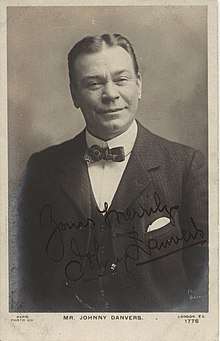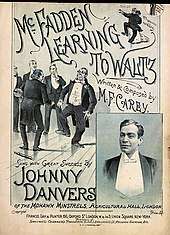Johnny Danvers
Johnny Danvers (December 1860 – 1 April 1939) was an actor and comedian and music hall performer who made a number of appearances in the annual pantomime at the Theatre Royal, Drury Lane in the late 19th and early 20th-centuries, usually with his nephew Dan Leno.

Early life
He was born in Sheffield in Yorkshire as John Danvers Harold, the son of Elizabeh Ann née Calow (1848-1894) and Charles Dutton Harold (1843-c1880). He moved to Glasgow as a boy and by 1881 he was back in Sheffield where he was a "silver plater".[1][2]
Dan Leno

In 1865 Dan Leno and his brother Henry formed a clog dancing double act known as "The Great Little Lenos".[3] Although initially successful, the brothers experienced many bouts of unemployment and often busked outside London pubs to make a living.[4] Tired of surviving on little or no money, Henry took up a trade in London and was replaced intermittently in the act by the boys' uncle, Johnny Danvers, who was a few weeks older than Leno.[3] Leno and Danvers had been close from an early age.[1]
Stage career

In the 1885 pantomime at the Surrey Theatre in London Danvers played Silly Billy in Robinson Crusoe,[5] while during 1886 he and Leno toured the music halls of northern England in a sketch called The Wicklow Wedding or, the Leprechaun's Revels written by Leno's stepfather for which Danvers and Leno helped paint the scenery while Leno helped his mother make the costumes.[6] Danvers moved to London in 1884 where he quickly became prominent in minstrel shows, appearing in blackface with the Mohawk Minstrels, who sat in a half-circle exchanging jokes and with whom he performed the popular hits 'Mc.Fadden Learning to Waltz',[7] 'I've Got the Ooperzootic' and 'Hist! Here Comes the Bogeyman.[8] He rose through the ranks of the troupe and became 'Mr. Tambo', who shared the comedy with the 'Mr. Interlocuter' of Harry Hunter and the 'Mr. Bones' of Johnny Schofield.[9] He later appeared with the more famous Moore & Burgess's Minstrels.[10] Other songs Danvers popularised included 'I Had No Luck That Day'[11] and 'I Know A Gal Dat Lubs A Coon' (1904).[12]
In 1895 in London he married Emily Rosetta King (1869-1955).[13] They had no children. In 1898, Leno, Herbert Campbell and Danvers formed a consortium to build the Granville Theatre in Fulham, which was demolished in 1971.[14]
Drury Lane and after

Danvers joined Leno in the annual pantomime at the Theatre Royal, Drury Lane in December 1898 in The Forty Thieves in which Danvers played Ali Baba,[15] while in December 1899 in Jack and the Beanstalk he appeared again with Leno and Herbert Campbell.[16] In 1899 Danvers appeared with Leno in the musical farce In Gay Piccadilly! by George R. Sims. In 1905 he played King Ivory of Oddland in the Drury Lane pantomime The White Cat, Snap in Cinderella in 1906, a Robber in Babes in The Wood in 1907, and Alderman in Dick Whittington in 1908.[17] During 1911 and 1912 he was touring with Agnes Fraser and Walter Passmore in the musical farcical sketch Sweet Williams.[18]
He played Wurzberger in Baron Trenck (1911) at the Strand Theatre; Sarah in the pantomime Dick Whittington and His Cat at the Lyceum Theatre (1911); Laurens in Good News at the Princes Theatre (1917); and Mr. Middlemark opposite the Ebenezer Scrooge of Seymour Hicks in Scrooge at the Princes Theatre in London (1917).[19]
Later years
In 1920 he played Mr. Hooley in the revival of The Shop Girl at the Gaiety Theatre;[20] Mr Belcher in Old Bill, M.P. (1922) at the Golders Green Hippodrome;[21] Count Hogginarmo in the pantomime The Rose and the Ring at Wyndham's Theatre (1923);[22] and 'Old Bill' in Bruce Bairnsfather's musical comedy Carry On Sergeant! (1925) at the New Oxford Theatre in London.[23] The show failed, running for only 35 performances and with Danvers described as "an excellent Old Bill and his cheery optimism and broad good humour kept things from flagging at several awkward moments."[24]
Danvers died in Brixton on 1 April 1939[25] aged 78 and is buried in Streatham Park Cemetery.[26]
References
- Barry Anthony, The King's Jester: The Life of Dan Leno, Victorian Comic Genius, London: I. B. Taurus & Co (2010) - Google Books pg.33
- 1881 England Census for John Danvers Harold: Yorkshire, Sheffield, North Sheffield - Ancestry.com (subscription required)
- Gyles Brandreth, (1977) The Funniest Man on Earth: The Story of Dan Leno, London: Hamish Hamilton
- Brandreth, p. 3
- Anthony, pg. 62
- Anthony, pg. 67
- Sheet music for 'Mc.Fadden Learning to Waltz' sung by Johnny Danvers - Victoria and Albert Museum Collection
- Michael Pickering, ;;Blackface Minstrelsy in Britain, Ashgate Publishing (2008) - Google Books
- Anthony, pg. 70
- Johnny Danvers (c1901) - British Music Hall Artists - Florrie and Arthur Gallimore website
- Johnny Danvers - Music Hall Lyrics Collection
- 'I Know A Gal Dat Lubs A Coon' (1904) - Music Hall Lyrics Collection
- England & Wales, Civil Registration Marriage Index, 1837-1915 for John Danvers Harold 1895 - Ancestry.com (subscription required)
- "From the Archives: The Granville Theatre" Archived 6 October 2013 at the Wayback Machine, Hammersmith and Fulham News, 6 October 2009, p. 66
- J. P. Wearing, The London Stage 1890-1899: A Calendar of Productions, Performers, and Personnel, Rowman & Littlefield (2014) - Google Books pg. 399
- Johnny Danvers, Dan Leno and Herbert Campbell in 'Jack and the Beanstalk' - Collection of the National Portrait Gallery, London
- History of the Drury Lane Pantomimes - It's Behind You website
- Postcard of Johnny Danvers, Agnes Fraser and Walter Passmore in the musical farcical sketch Sweet Williams 1911 and 1912 - Footlight Notes website
- J. P. Wearing, The London Stage 1910-1919: A Calendar of Productions, Performers, and Personnel, Rowman & Littlefield (2014) - Google Books
- J. P. Wearing, The London Stage 1920-1929: A Calendar of Productions, Performers, and Personnel, Rowman & Littlefield (2014) - Google Books, pg. 15
- Wearing, 1920-1929, pg. 176
- Wearing, 1920-1929, pg. 260
- Wearing, 1920-1929, pg. 396
- Carry On Sergeant! at the New Oxford Theatre (1925) - Bruce Bairnsfather website
- "Johnny Danvers Dead", Sunderland Echo and Shipping Gazette, 3 April 1939, p. 5.
- Resting - The Music Hall Guild of Great Britain and America